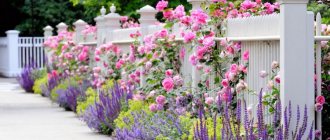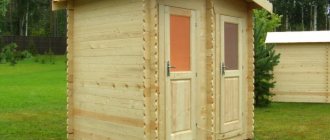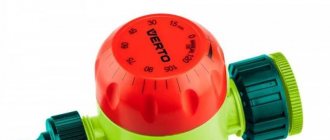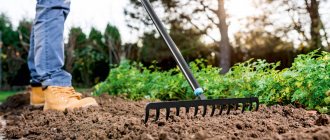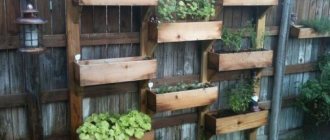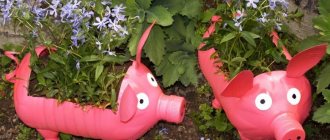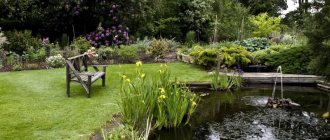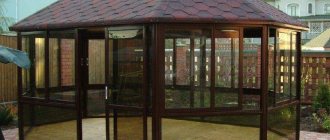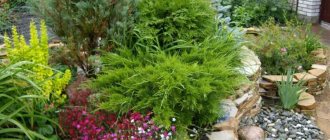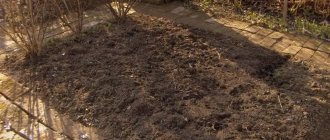SHARE ON SOCIAL NETWORKS
FacebookTwitterOkGoogle+PinterestVk
To make life easier for gardeners and gardeners, design engineers and craftsmen are constantly inventing a variety of irrigation systems. There are many ways to water plants, from using a regular watering can to automatic watering systems. Which irrigation system is preferable to use at the dacha, how to properly organize watering of the site, what methods of installing irrigation systems are most popular - all this information is described in detail in this article.
An irrigation system is an indispensable attribute of any private home or summer cottage.
Types of irrigation systems for gardens and cottages
Existing irrigation systems can be divided into four categories, each of which has characteristic advantages and disadvantages:
- surface watering;
- drip irrigation;
- subsurface irrigation;
- sprinkling.
Each type of green space and garden crops needs different methods of watering
Helpful advice! At your summer cottage, you can organize several irrigation systems, since each crop needs a certain moisture regime.
Surface irrigation is a less expensive irrigation option. Water is supplied to the plant through dug grooves directly from a hose, which can be connected to a centralized water supply system or to a barrel for irrigation in the country. You can buy a container of any capacity. The irrigation system is located on the surface of the ground, so installing it yourself is not difficult. This method deprives the roots of some oxygen, which can be detrimental to plants. Therefore, constant use of surface watering is not recommended.
Subsurface irrigation system for greenhouses
Subsurface watering is carried out using an irrigation system, which is located under the soil layer at a depth of 30 cm. Mini-holes are made throughout the entire area of the pipes, through which water flows to the roots of the plants. This system is most rational for green spaces such as trees, fruit bushes, and grapes. It is also successfully used in greenhouses where regular digging is not carried out. However, it can also be used in a summer cottage, planting annual plants depending on the location of the system.
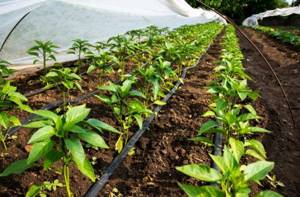
Surface irrigation system is commonly used in greenhouses
This option promotes good oxygen access to the roots and does not require constant loosening of the soil. Underground irrigation is organized in areas with water scarcity, since this option reduces its consumption by half compared to the surface option. Watering can be carried out from a watering tank at the dacha.
Helpful advice! To minimize the likelihood of clogging the holes in the pipeline, a filter should be installed at the beginning of the irrigation pipe.
The system can be laid vertically at the time of planting the perennial plant. The planting hole is made 30 cm deeper and 20-25 cm wider than required for rooting the crop. The bottom is covered with a layer of crushed stone 20 cm high. The pipe is inserted vertically, plunging 7-10 cm into the thickness of the crushed stone. The length of the segment is selected taking into account the protrusion of part of the product above the ground surface by 10-12 cm. The pillow is covered with soil 10-15 cm thick. Open end closed with a plug.
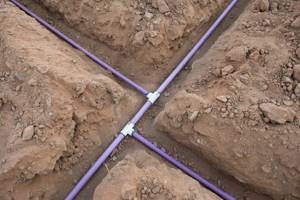
Underground irrigation allows you to save water and at the same time evenly moisturize the soil from the inside.
Watering is carried out from a watering can or hose directly into the pipe. Water goes directly to the plant's root system, eliminating the need to moisten the top layer of soil. The irrigation rate depends on the climate zone of the area. For many plants of the same type, automated watering can be organized.
Rain garden watering system: features of the option
When organizing a sprinkler system, water in the form of drops gradually moistens the soil near the plant at a certain angle. This process is carried out using special sprinklers and sprinklers, which are installed in certain places of the summer cottage at a certain distance from each other. For areas completely covered with vegetation, such as lawns and flower beds, rotating sprinklers are provided that evenly moisten the soil around them.
Sprinkling promotes gradual, high-quality and deep moistening of the soil, due to which its structure is not damaged. With this method, the above-ground parts of the plant are saturated with moisture, which contributes to increased productivity. This is especially true for strawberry plantations. If the sprinkler nozzles are located under the tree crowns, they will simultaneously water and wash away dust and insects from the leaves. In addition, if lawn grass is planted under the trees, this is the most rational way to moisten it.
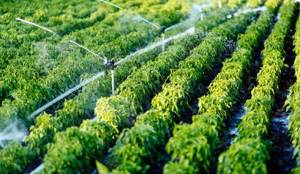
Sprinkler irrigation is often used for lawns and long beds.
When setting up the device, you should focus on maintaining a balance between the intensity of rain and the ability of the soil to absorb water. Moisture must have time to be absorbed into the soil to prevent the formation of puddles and dirt. This can lead to the surface of the earth floating, which, after drying, will become covered with a crust, which will prevent the access of oxygen to the roots of plants.
One of the disadvantages is that water is sprayed unevenly during strong gusts of wind and insufficient pressure in the main system. Also, water can get not only into the beds, but also onto the paths.
The sprinkler system can be stationary or portable. In the first option, irrigation pipes are laid on top of the soil or mounted in the ground to a depth of 30-40 cm. In places where sprayers are installed, vertical sections of pipelines are brought to the required height. Sprinkler nozzles are attached to their ends.
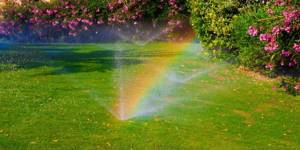
The sprinkler system can be of above-ground or underground type and consist of several sprinklers that uniformly moisten the area
When organizing portable irrigation, hoses are used for watering in the country. The best products are made from thermoplastic elastomer or PVC. Sprayers are installed at the ends of the hose. The products are placed in the required place for watering garden crops. For this system, it is convenient to organize automatic watering, which will be programmed to turn on at the most suitable time for watering - in the evening. By morning, the water will be absorbed, and during the day you can loosen the soil to ensure oxygen access to the roots of the plant.
Operating principle and distinctive features of drip irrigation
Do-it-yourself drip irrigation at the dacha is the most economical and rational irrigation option. The principle of operation of the system is based on the flow of water in small portions directly to the roots of the plant through a drip tape connected to an irrigation pipe. This option is possible when supplying water to the central water supply for irrigation in the country. If it is served by the clock, then moisturizing will occur in the same way.
Such irrigation can be carried out from a storage tank for irrigation at the dacha if there is no water in the main pipeline. This option will ensure round-the-clock irrigation of the soil.
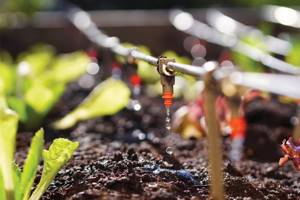
Drip irrigation is one of the popular methods of irrigating flower beds and greenhouses
This method of watering does not interfere with air access to the roots of the plant and does not contribute to the deterioration of the soil structure. In this case, you can avoid drying out or flooding the soil and refuse to regularly loosen the soil. The main disadvantage of such an irrigation system is the high probability of pipe clogging, which occurs as a result of small debris and soil particles entering its cavity. Therefore, the system needs periodic cleaning.
This type of watering can be done using drip tape, a rigid hose with small holes, or small-diameter plastic pipes. The elements are laid along the bed with plants and connected to a common pipe. To organize watering of several rows, a splitter is mounted, which is located at the beginning of the bed. It promotes uniform distribution of tape segments. The tape is laid in a spiral around the tree trunk. Plastic pipes are usually installed along permanent beds. Holes are first made in them using a hot awl.
Making your own drip irrigation function
The essence of the method is to supply water from a storage tank under a certain pressure, and the pipes are equipped with special droppers, which are located in close proximity to the root system. The disadvantage of operation is that normally water is supplied only to the nearest droppers, while other elements suffer from a lack of water. With increased pressure, the first nearby elements will experience excess moisture, so it is necessary to develop a high-quality pressure system.
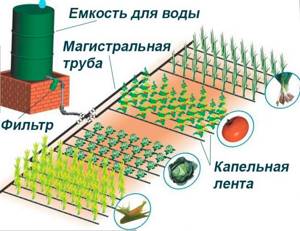
Drip irrigation installation diagram
If you decide to use this particular irrigation system, you should pay attention to several of its constituent elements:
- Pipeline type system, presence of distribution units. Traditionally, preference is given to products made of metal plastic.
- Valves – these components are required to regulate the water supply process, that is, if the limit is exceeded, the valve prevents subsequent supply.
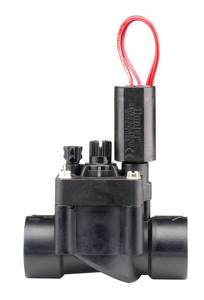
Valve for automatic watering
- Counter - this element is needed to obtain information about the amount of water that is spent. Without it, problems may arise in determining the amount of water supplied to the plants.
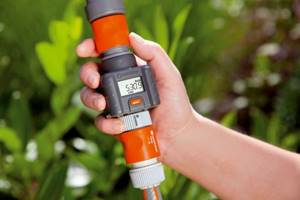
Meter for automatic watering
- Water filters are presented in great abundance, so it will not be difficult for the user to choose the right one, based on the quality of the water supplied. If the level of contamination is high, you should give preference to products with an automatic washing option.
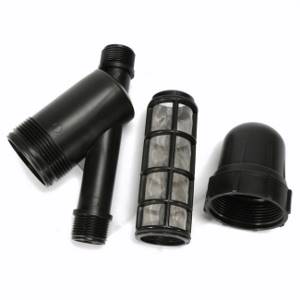
Mesh filter for automatic watering
- Fertilizer units - they can be specially mounted separately from the tank and serve for high-quality application of liquid and granular fertilizers. The fertilizer will react with the water in the pipes and be supplied to the plant through a dripper.
- Connecting and silencing mechanisms must be used in places where pipes branch.
So, the answer to the question of how to make automatic watering at the dacha is quite simple, so it is necessary to rationally ensure the organization of this system by first drawing a diagram of the site and depicting beds with plants on it. This will allow you to calculate the number of connectors and droppers required.
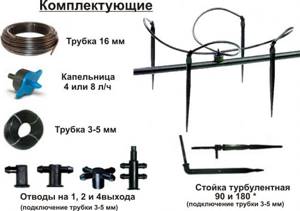
Accessories for drip irrigation system
Irrigation system at the dacha depending on water supply
Water can be supplied to the irrigation system in one of the following ways:
- automatic;
- semi-automatic;
- mechanical.
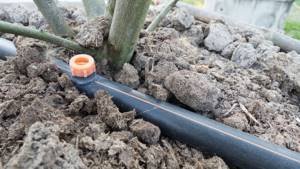
Each method of supplying water to the root system of a plant has both its advantages and disadvantages.
The first option is carried out depending on the wishes of the owner and is set by a special program. In this case, the start time for watering is set or humidification sensors are installed, relative to which water will be supplied. You can buy such a system ready-made or organize automatic irrigation yourself.
When installing an automatic system, a self-priming pump must be used for watering a vegetable garden, home garden, or cottage, which pumps water from a container. When choosing a unit, you should pay attention to the frequency of engine adjustment and the possibility of a soft start. It is connected to a switch-on timer that controls the operation of the pumping unit.
When organizing automatic watering at your dacha with your own hands, you can purchase a socket with a timer, which involves daily or weekly irrigation. This system is most often used for sprinkling. However, it can be organized for other options. Wells, reservoirs located near the land plot, or a centralized water supply system can be used as water storage facilities.
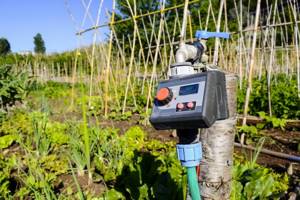
The automatic watering system is convenient because it irrigates at a specified time and does not require much human effort.
Semi-automatic irrigation involves manually supplying water to the common pipe. Then the system independently distributes the liquid through the pipes, regulating its flow and pressure.
Helpful advice! At any time, by changing the settings, you can switch from semi-automatic to automatic mode without turning off the water supply tap.
With mechanical watering, the moistening of the beds is controlled by a person who manually opens the watering tap at the dacha, selecting the required pressure.
Types of automatic watering
Automatic watering at the dacha is the best opportunity to simplify your life in your dacha or garden plot and impressive savings of money. In case of rational distribution of irrigation liquid, the consumption of this raw material can be saved. The practical side of the issue implies the presence of three basic types of irrigation systems.
- Rain technology involves water entering from above. In this way, the plant leaves are irrigated, dust is removed from them, while the soil remains unchanged. This type is the most effective because it is as close as possible to natural hydration.
- The drip variety is the most economical because it does not involve the expenditure of water on the surface of the plant or on the soil that is nearby. In this case, the roots are not affected either - it turns out that the soil is fully moistened to the extent necessary. This type of irrigation is an ideal solution for those with a large garden area and a limited amount of water.
- The subsurface form of automatic watering for the garden and garden involves saturating the soil with moisture, while the top layer remains dry. That is, water comes from within, and this form of interaction helps protect the stems and leaves of plants from rotting, and also prevents the growth of weeds.
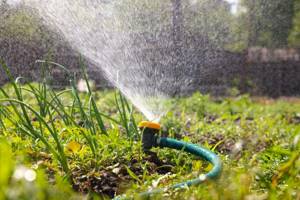
Rainfall irrigation technology has efficient irrigation
In general, the system can operate on an automatic or mechanical principle. In the first case, you will not need to monitor the amount of water and frequency of watering the beds. This is due to the fact that all functions are clearly adjustable and subject to automatic control. This type of installation is designed to last over 10 years, but manufacturing will require a considerable amount of money. Sometimes a semi-automatic scheme is used that launches the option at the required time. Automatic watering at the dacha can be organized with your own hands, but for this you will have to carry out a set of rational measures to prepare for work.
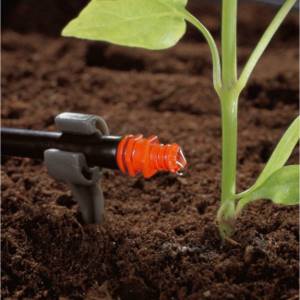
Drip irrigation
Selection of pipe material for irrigation in the country, product characteristics
Before organizing irrigation at your dacha, you should decide on the material of the pipelines for the selected irrigation system. Metal products are characterized by strength, reliability, durability and affordable cost. Among the negative factors are the high cost of shaped connections and shut-off valves, the susceptibility of products to corrosion, and the complexity of installation, which requires special skills and abilities.
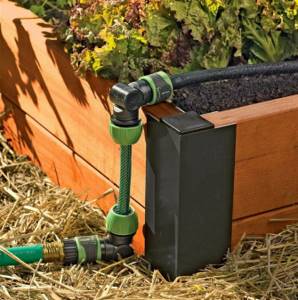
The quality of pipes and materials is the key to long-term service of the irrigation system
Plastic products are more modern, practical and inexpensive. The walls of the pipes are extremely smooth, so that deposits will not accumulate inside the pipelines, which eliminates a decrease in the throughput of the product. The material is characterized by strength and durability.
Related article:
Irrigation hoses: which ones are better depending on the purpose and operating conditions Which ones are better to buy based on the material of manufacture, type and purpose of the product. Recommendations for choosing a tool. Operating and storage conditions.
HDPE pipes for irrigation in the countryside do not respond to temperature fluctuations or exposure to aggressive environments, and can be used for above-ground and underground installation. The connection of PVC system elements is carried out using glue, mastic and structural fittings - this can be done independently, without having special skills.
Among the most popular manufacturers of polyethylene pipes are the companies Rehau, Wavin and Ostendorf, which produce high-quality products with high technical and operational characteristics. The price of pipes for irrigation at the dacha is 50-90 rubles/m.
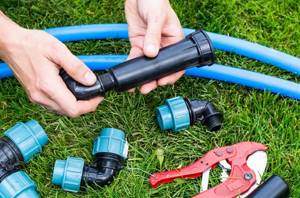
By choosing pipes produced by well-known brands, you can be confident in the quality and durability of the products
The most durable and flexible are polyethylene pipes, which do not burst when water freezes. The most optimal option is considered to be a product diameter of 20-40 mm. The system elements are connected using the soldering method. Polypropylene pipes are a more economical option. They have increased strength and durability. Individual sections are connected by soldering joints or fastening with couplings. You can buy pipes from well-known manufacturers Rehau, Aquatherm, Banninger, Wefatherm, Ekoplastik, Valtek, Pilsa, Pro Aqua, Santrade for 30-60 rubles/m.
Drip irrigation from polypropylene pipes
If we compare pipes made of metal and polypropylene, the latter have more advantages. In addition, the material is lower in cost and is better suited for self-assembly of drip irrigation.
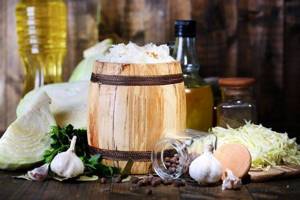
Pickling cabbage in jars for the winter: proven recipes - unusually crispy!
DIY garden figures - features of application, lighting and decoration (80 photos)

DIY swings - the best ideas and options for making a homemade swing (130 photos)
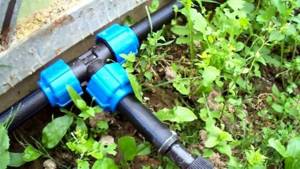
At the beginning of assembly, you need to take care of the following points:
- You will need a 100 liter container. The temperature of the water in it will increase under the influence of sunlight. This also has a positive effect on plant growth.
- Ball valve and filter for water purification. If it is missing, the system will malfunction.
- Bottle for mineral fertilizers
- Pipeline
- Bends from polypropylene pipes.
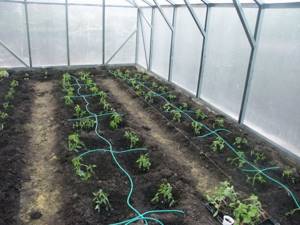
To determine the size of materials, you need to mark the ground. For irrigation purposes, 1 square meter of area will require approximately 30 liters of water in 24 hours. At the same time, it is necessary to calculate the number of branches and the length of the segment between the droppers.

To maintain the normal pressure, the bottle is fixed at a height of 1-2 m. The tap is installed at a height of 10 cm from the bottom. On the opposite side it is attached to the country water supply.
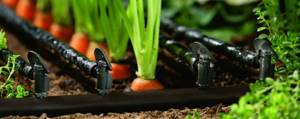
To fix the set level, it is better to place a valve with a float. Installation of pipes for drip irrigation must be strictly followed according to the instructions. For everything to work correctly, the pipes must be secured to the fittings using soldering.
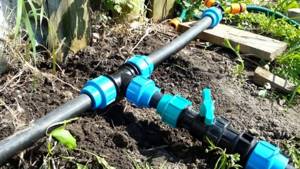
The pipes come into contact with the main line at a depth of 75 cm. The filtration installation is located on the side. At the end of the main pipe, a plug is made. After all this, you can start drips. That's all, the drip irrigation system is ready for use!
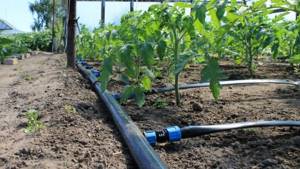
How to do watering at the dacha with your own hands: main points
Creating an irrigation system begins with planning. At the first stage, you should draw a diagram of the site with all the beds and plants that need watering. Next, all options for water supply are provided, which can be carried out from a centralized water pipeline or from an irrigation tank at the dacha. You can buy a tank of any capacity in a specialized store. It is installed at a height of two meters and has a lid on top to prevent debris from accumulating in the water.
If there is a well or well on the site, you can organize an alternative water supply system. In this case, you should decide on a pump for irrigation at the dacha, which is selected taking into account the required flow rate.
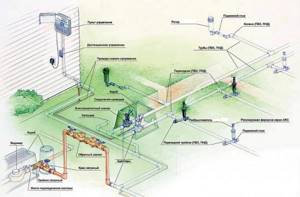
Layout of the automatic irrigation system on the site
Important! The irrigation system at the dacha made of plastic pipes should be located in such a way that the entire territory is covered. Otherwise, the missed area will have to be watered manually.
The drawing should indicate pipelines and shut-off valves. Here it is necessary to note all connections and interweavings of pipes. Based on this, it is necessary to calculate the total number of plugs, tees, splitters, start connectors (in the case of organizing drip irrigation), sprinklers (when installing a sprinkler system). Subsequently, a list of necessary materials and equipment is compiled for arranging a water supply system at the dacha for irrigation with your own hands.
It is better to choose plastic pipes for the main pipeline, since they can supply fertilizer or fertilizer dissolved in water. If a subsoil system is being implemented, preference is given to thick-walled products. When laying above ground, an opaque material is used, which will help to avoid water blooms inside the pipelines.

Since pipes for an irrigation system are usually installed for more than one season, you should carefully select products and pay attention to quality
Helpful advice! You should not skimp on materials for your irrigation system. Since it is installed for many years, it is worth choosing high-quality, certified products.
In the case of organizing an automatic irrigation system, it is necessary to purchase an electric controller. It is powered by self-contained batteries. It is also recommended to stock up on filters that will protect the system from clogging. This is especially important for drip irrigation.
Automatic watering in the country: basic rules and principles of watering
For the irrigation system to operate efficiently, you need to follow some basic rules:
- Regardless of the degree of automation of the irrigation system, you should not completely distance yourself from this process. The lack of loosening in irrigation makes this process minimally effective, and a crust forms on the soil surface, preventing moisture from penetrating inside. It must be loosened, since the soil is saturated with the necessary substances.
- It is not advisable to use cold water to operate the system. It is best to give preference to settled water heated in the sun. This is due to the fact that cold exposure has a negative effect on the root system as a whole.
- It is necessary to distribute plant crops throughout the site so that it becomes possible to divide it into zones in accordance with the degree of humidity: plants that love water are placed on one side, and those that are prone to growing in arid climates are placed on the other. This facilitates simple organization of the irrigation system.
- If irrigation work is carried out directly from a hose, the stream of water should not be directed strictly at the root, as this can lead to serious damage to the root system and cause rotting. An important role is played by the uniformity of irrigation work, that is, water should be absorbed into the soil everywhere.
- When there is a need to retain moisture in the soil, you can cover it in the holes with straw. In this case, the ground will remain wetter, since a barrier will be created that prevents the immediate evaporation of the humid environment.
- If a period of drought occurs, watering should be plentiful, but not frequent. The fact is that with frequent supply of liquid, but shallow exposure, the roots will not receive moisture in sufficient quantities. As a result, a crust forms, which becomes a barrier to saturating the roots with water.
If you decide to buy automatic watering for your dacha, you need to choose and install it wisely!
Advantages of the sprinkler method
The sprinkling method is used when surface irrigation of a certain area is necessary. The main advantage of sprinkling is the humidification of the air while effectively irrigating plants. With the sprinkler irrigation method, plants may suffer from sunburn, so on hot and sunny days it is better to irrigate in the morning or evening. This method makes it possible to use additional fertilizers that are added to the water. Sprinkler irrigation is most often used to irrigate the lawn.
However, it is worth considering that when using sprinkling, water should go into the soil and not form puddles on the surface, otherwise a crust will appear after they dry out. This crust prevents the passage of oxygen to the roots of plants, which is an important part for their development. In addition, the disadvantage of sprinkling is the rather significant energy intensity of this process. In addition, in extreme heat, especially on heavy soils, its use is not recommended.
Are there any disadvantages?
Any system has certain disadvantages; perhaps, if the area is small, there are few plants, and the owners constantly live nearby, it is easier to water manually. But most owners of dachas and cottage plots are inclined to believe that automatic watering is still needed. The main disadvantage of an automatic irrigation system is the monetary cost of equipment. If the work on arranging the site with automatic watering is carried out by specialists, this will entail additional expenditure on labor costs.
When installing automatic watering yourself, you need to know certain features and nuances, and you also need some skills. Automatic irrigation will require a stable water supply of sufficient power. The design of the system should be carried out by a specialist, and he will require a detailed site plan, as well as many other data. Most owners of a properly designed, installed and configured irrigation system believe that they made the right choice.

